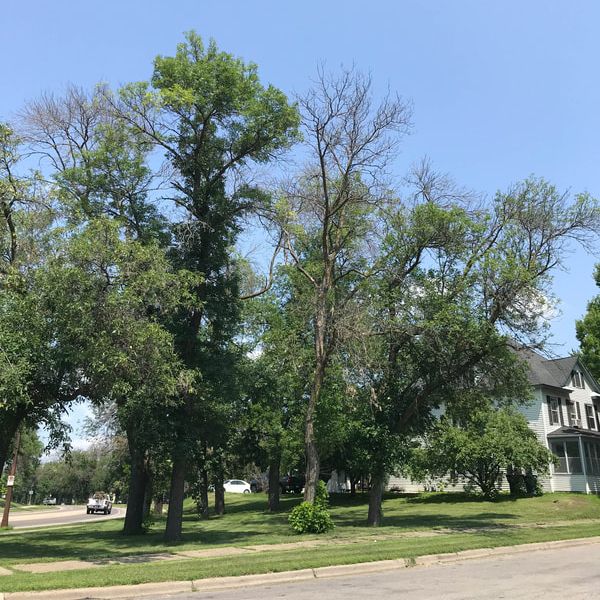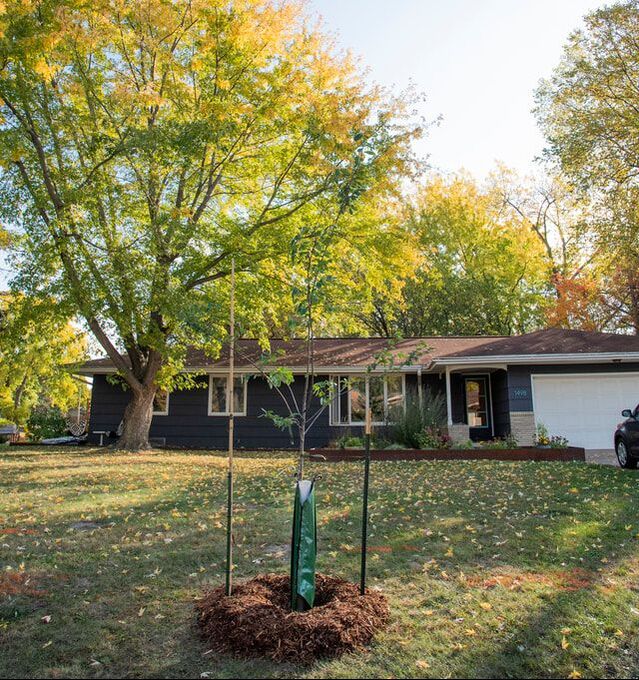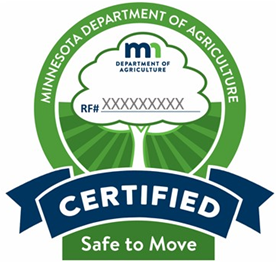grants to help communities protect their community forest against emerald ash borer
|
The Minnesota Department of Natural Resources has $2.4 million to provide grants to local and tribal governments to assist in managing public ash trees for emerald ash borer (EAB). Funds can be used to treat, remove, and replant ash trees. Ash trees within 10 miles of a known EAB infestation can be treated with a non-neonicotinoid insecticide.
Tribal and local units of government in Minnesota, including cities, counties, regional authorities, joint powers boards, towns and parks and recreation boards in cities of the first class (more than 100,000 residents), are eligible to apply. Even if emerald ash borer has not reached a community, now is the time to take advantage of grant funds to prepare for its arrival. This is why additional eligible activities includes: planting a diversity of trees including site preparation, mulch, water bags, staking material, and tree wrap or guards; hiring technical assistance; conducting a tree inventory; developing an EAB management plan; and engaging and educating the public using the help of Tree Trust and the University of Minnesota’s Tree Steward Program. Applicants can request a maximum of $150,000. No minimum request or match is required. All work must be done on public or tribal lands. Applications due by Mon., Jan. 24. A full list of eligible activities, application materials and a list of frequently asked questions are available online. Priority will be given to projects that remove or replace ash trees which pose significant public safety concerns and benefit underserved and areas of concern for environmental justice. Funding for this project was provided by the Minnesota Environment and Natural Resources Trust Fund as recommended by the Legislative-Citizen Commission on Minnesota Resources (LCCMR). |
Are your Trees Storm Ready?
|
A newly published video resource from the Illinois Department of Natural Resources is a nicely produced and succinct overview about identifying potential tree problems. The video is aimed at homeowners and the general public. This may be a nice resource if you are looking for a way to communicate with your community about some of these issues. Also, remember there is a website to find local certified arborists here: https://www.treesaregood.org/findanarborist
MDA Certified Firewood in MN
|
The Minnesota Department of Agriculture is the agency responsible for certifying firewood producers in Minnesota. There are currently twelve Minnesota Certified Firewood Producers.
Remember it is illegal to transport hardwood firewood out of Minnesota quarantined counties unless it is MDA certified firewood. Moving uncertified hardwood firewood out of quarantine counties is illegal and is punishable up to a $7,500 fine per violation per day. |
The folks at MDA were kind enough to put together an updated fact sheet for the Tree Inspector Program.
Declining Health of Bur Oaks in Minnesota
Summary of the Results from the 2017-2018 Statewide Survey
Alissa Cotton, Gary Johnson, & Ryan Murphy
University of Minnesota, Department of Forest Resources
|
What is tree health decline? According to the Morton Arboretum in Lisle, Illinois and their tree health and physiology lab, “When shade trees and shrubs gradually lose vigor and display pale green or yellow color, small leaves, poor growth, early leaf drop, early fall color, and dieback of twigs and branches, it is referred to as tree “decline.” There are some “declines” caused by specific diseases and environmental stresses, but …a general decline… no specific cause has been identified.” RaMBO? The reported “rapid” decline in health of bur oaks (Quercus macrocarpa) in Minnesota, cleverly titled RaMBO (rapid mortality of bur oaks…get it?) has been noted, discussed, and debated by tree health professionals and all oak lovers for several years. During the period of 2010-ish to 2017, many believed that the decline and subsequent death of Minnesota’s most ubiquitous oak (it is native to every ecological province [4] in Minnesota) was tracking faster and more deadly. This followed the identification and heightened awareness of the native fungal causal agent (Tubakia iowensis) of the disease “bur oak blight” in the early 2000’s in Iowa. Oak lovers were put on high alert, fearful that their beloved “monarch of Minnesota trees” was fated to suffer the ugly decline as American elms did. However, was the perceived decline unique to one causal agent, to all of or only part of the state, and was it in fact a “rapid” decline and possible death? Paraphrasing the Law of the Instrument, “if the only tool you have is a hammer, it’s tempting to treat everything as if it were a nail.” Maybe we are only seeing what we want to see? This and other questions were the reason for conducting a statewide survey on bur oak health by the University of Minnesota. Do Bur Oaks Decline and Die Rapidly? When was the last time you saw a bur oak die “all of a sudden.... Continue Reading |
Growing Equitable Community Forests
Listen
Why we need trees in Minnesota cities
MPR News host Angela Davis chats with UMN Urban Forestry Professor Eric North and Tree Trust Director of Community Forestry and MnSTAC President Karen Zumach about the benefits of our community trees and ensuring these benefits reach everyone.
MPR News host Angela Davis chats with UMN Urban Forestry Professor Eric North and Tree Trust Director of Community Forestry and MnSTAC President Karen Zumach about the benefits of our community trees and ensuring these benefits reach everyone.
Watch
How Systemic Racism Linked to Fewer Trees in Your City
Tree canopy takes decades to develop, and the decisions we make today will affect what canopy exists in the future. Learn how practices from the past such as redlining have shaped our current community forests and strategies for reversing this trend.
Tree canopy takes decades to develop, and the decisions we make today will affect what canopy exists in the future. Learn how practices from the past such as redlining have shaped our current community forests and strategies for reversing this trend.
Learning Arborist Knots with Nick Neylon
|
Have you ever been jealous of arborists' knot tying prowess? Looking to pick up some new skills this winter on your down time? Learn a new knot each week from UMN UFOR lab researcher Nick Neylon. Instructional videos will be posted on the University of Minnesota Urban Forestry Outreach and Research (UFOR) Lab's YouTube page. Subscribe to the UFOR YouTube page to catch all the new knot videos as they are released. You can check out Nick's first two videos right below.
|
2021 Virtual MnSTAC Forum Recordings
Each month, the Minnesota Shade Tree Advisory Committee (MnSTAC) in collaboration with the University of Minnesota Urban Forestry Research and Outreach (UFOR) lab hosts a monthly forum on topics of interest to the MN urban forestry community. Below you can find the most recent recordings of the 2021 forum series to date since the last TreeIQ edition. To stay current with upcoming forums and other community forestry news, please visit www.mnstac.org and subscribe to the weekly newsletter.
December
Hickories in Horticulture: Novel Options for Diversifying Managed Landscapes
As severe weather events and the introduction of invasive pests occur more frequently in the United States, limited biodiversity and the resiliency of managed landscapes has come into question. Those that manage green spaces recognize the value of diversifying urban forests with species and selections of plants capable of tolerating the demands of a changing landscape and climate. Yet modern trends in the nursery supply chain have led to the repetitive use of easily grown, closely related taxa. Of the multitude of underutilized trees that could be used more broadly in managed landscapes are hickories [Carya (Nutt.)]. The genus Carya includes many stately, native trees, that offer superior ornamental features with great promise for application in urban environments. Hickories (Carya spp.) have long been sought after by horticulturists for their ornamental value yet have not been integrated into commercial nursery production due to limited propagation techniques, slow growth, and claims of poor transplant success. A focused interest in planting these trees could drive their development as nursery crops while research aimed at resolving production issues could expand their availability in the green industry. In this presentation we will introduce species of hickory with potential for application in Minnesota as well as review myths and current issues with their integration into horticulture.
Speaker: Brandon Miller PhD, Assistant Professor, Department of Horticultural Science, University of Minnesota
Hickories in Horticulture: Novel Options for Diversifying Managed Landscapes
As severe weather events and the introduction of invasive pests occur more frequently in the United States, limited biodiversity and the resiliency of managed landscapes has come into question. Those that manage green spaces recognize the value of diversifying urban forests with species and selections of plants capable of tolerating the demands of a changing landscape and climate. Yet modern trends in the nursery supply chain have led to the repetitive use of easily grown, closely related taxa. Of the multitude of underutilized trees that could be used more broadly in managed landscapes are hickories [Carya (Nutt.)]. The genus Carya includes many stately, native trees, that offer superior ornamental features with great promise for application in urban environments. Hickories (Carya spp.) have long been sought after by horticulturists for their ornamental value yet have not been integrated into commercial nursery production due to limited propagation techniques, slow growth, and claims of poor transplant success. A focused interest in planting these trees could drive their development as nursery crops while research aimed at resolving production issues could expand their availability in the green industry. In this presentation we will introduce species of hickory with potential for application in Minnesota as well as review myths and current issues with their integration into horticulture.
Speaker: Brandon Miller PhD, Assistant Professor, Department of Horticultural Science, University of Minnesota
November
Forest Health Observations from a Dry 2021
Believe it or not, not all forest tree problems from 2021 were from drought. Some of them stemmed from the floods of 2019 and others had to do with hungry squirrels! The drought certainly aggravated stresses of the past, caused problems of its own, and set up many trees for problems in 2022. Drought-related tree problems like leaf scorch, twolined chestnut borer, and pine engraver beetles will be covered. Other forest health items we observed will be sprinkled throughout the talk as well.
Speaker: Brian Schwingle, Department of Natural Resources
Forest Health Observations from a Dry 2021
Believe it or not, not all forest tree problems from 2021 were from drought. Some of them stemmed from the floods of 2019 and others had to do with hungry squirrels! The drought certainly aggravated stresses of the past, caused problems of its own, and set up many trees for problems in 2022. Drought-related tree problems like leaf scorch, twolined chestnut borer, and pine engraver beetles will be covered. Other forest health items we observed will be sprinkled throughout the talk as well.
Speaker: Brian Schwingle, Department of Natural Resources
This publication made possible through a grant from the Minnesota Department of Natural Resources and the USDA Forest Service. This institution is an equal opportunity provider.
In accordance with Federal law and U.S. Department of Agriculture (USDA) civil rights regulations and policies, this institution is prohibited from discriminating on the basis of race, color, national origin, sex, age, disability, and reprisal or retaliation for prior civil rights activity. (Not all prohibited bases apply to all programs.)
Persons with disabilities who require alternative means of communication for program information (e.g., Braille, large print, audiotape, American Sign Language, etc.) should contact the responsible State or local Agency that administers the program or USDA’s TARGET Center at (202) 720-2600 (voice and TTY) or contact USDA through the Federal Relay Service at (800) 877-8339. Additionally, program information is also available in languages other than English.
To file a complaint alleging discrimination, complete the USDA Program Discrimination Complaint Form, AD-3027, found online at http://www.ascr.usda.gov/complaint_filing_cust.html , or at any USDA office or write a letter addressed to USDA and provided in the letter all of the information requested in the form. To request a copy of the complaint form, call (866) 632-9992. Submit your completed form or letter to USDA by: (1) mail: U.S. Department of Agriculture, Office of the Assistant Secretary for Civil Rights, 1400 Independence Avenue, SW, Washington, D.C. 20250- 9410; (2) fax: (202) 690-7442; or (3) email: program. [email protected].
This institution is an equal opportunity provider.
In accordance with Federal law and U.S. Department of Agriculture (USDA) civil rights regulations and policies, this institution is prohibited from discriminating on the basis of race, color, national origin, sex, age, disability, and reprisal or retaliation for prior civil rights activity. (Not all prohibited bases apply to all programs.)
Persons with disabilities who require alternative means of communication for program information (e.g., Braille, large print, audiotape, American Sign Language, etc.) should contact the responsible State or local Agency that administers the program or USDA’s TARGET Center at (202) 720-2600 (voice and TTY) or contact USDA through the Federal Relay Service at (800) 877-8339. Additionally, program information is also available in languages other than English.
To file a complaint alleging discrimination, complete the USDA Program Discrimination Complaint Form, AD-3027, found online at http://www.ascr.usda.gov/complaint_filing_cust.html , or at any USDA office or write a letter addressed to USDA and provided in the letter all of the information requested in the form. To request a copy of the complaint form, call (866) 632-9992. Submit your completed form or letter to USDA by: (1) mail: U.S. Department of Agriculture, Office of the Assistant Secretary for Civil Rights, 1400 Independence Avenue, SW, Washington, D.C. 20250- 9410; (2) fax: (202) 690-7442; or (3) email: program. [email protected].
This institution is an equal opportunity provider.



